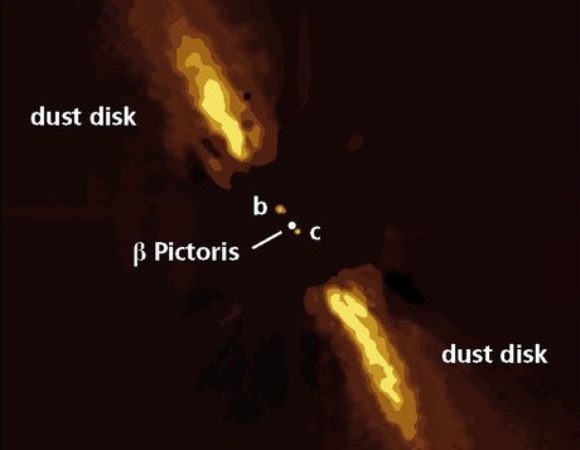Astronomers using ESO’s Very Large Telescope Interferometer have captured the first direct images of the recently-discovered giant planet Beta Pictoris c.
Source: Sci News
Beta Pictoris (β Pictoris) is the second brightest star in the constellation Pictor, about 63 light years away from Earth.
It hosts a circumstellar disk of gas and dust and a huge number of comets, some of which were seen falling onto the star.
Beta Pictoris is orbited by at least two 20-million-year-old giant planets: Beta Pictoris b and c.
Discovered in November 2008, Beta Pictoris b is a gas giant between 10 and 11 times the mass of Jupiter.
It orbits the parent star once every 22 years at a distance of 9.8 AU (astronomical units).
Astronomers directly imaged Beta Pictoris b several times between 2013 and 2018.
Beta Pictoris c, which was discovered in 2019 using radial velocity method, has a mass of 8.2 times that of Jupiters and is much closer to its star.
It orbits at 2.7 AU and has an orbital period of roughly 1,200 days.
An artist’s impression of the Beta Pictoris system. Image credit: Axel Quetz / MPIA Graphics Department.
The first direct images of Beta Pictoris c were captured using four 8.2-m Unit Telescopes and the GRAVITY instrument on ESO’s Very Large Telescope Interferometer.
“This is the first direct confirmation of a planet detected by the radial velocity method,” said Dr. Sylvestre Lacour, an astronomer at Observatoire de Paris and ESO and leader of the ExoGRAVITY observing program.
“We used GRAVITY before to obtain spectra of other directly imaged exoplanets, which themselves already contained hints on their formation process,” said Dr. Paul Molliere, a postdoctoral researcher at the Max Planck Institute for Astronomy.
“The brightness measurement of Beta Pictoris c, combined with its mass, is a particularly important step to constraining our planet formation models.”
“It is amazing, what level of detail and sensitivity we can achieve with GRAVITY,” said Dr. Frank Eisenhauer, an astronomer at the Max Planck Institute for Extraterrestrial Physics and lead scientist of the GRAVITY project.
“We are just starting to explore stunning new worlds, from the supermassive black hole at the center of our Milky Way Galaxy to planets outside the Solar System.”
The findings appear in two papers in the journal Astronomy & Astrophysics.
Source: Sci News

































Leave a Comment
You must be logged in to post a comment.